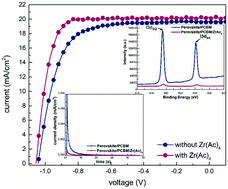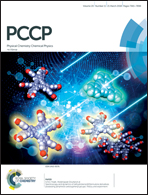Improved fill factor in inverted planar perovskite solar cells with zirconium acetate as the hole-and-ion-blocking layer†
Abstract
Planar perovskite solar cells (PSCs) have gained great interest due to their low-temperature solution preparation and simple process. In inverted planar PSCs, an additional buffer layer is usually needed on the top of the PCBM electron-transport layer (ETL) to enhance the device performance. In this work, we used a new buffer layer, zirconium acetate (Zr(Ac)4). The inclusion of the Zr(Ac)4 buffer layer leads to the increase of FF from ∼68% to ∼79% and PCE from ∼14% to ∼17% in the planar PSCs. The UPS measurement indicates that the Zr(Ac)4 layer has a low HOMO level of −8.2 eV, indicating that the buffer layer can act as a hole-blocking layer. Surface morphology and surface chemistry investigations reveal that the elements I, MA and Pb can diffuse across the PCBM ETL, damaging the device performance. The covering Zr(Ac)4 molecules fill in the pinholes of the PCBM layer and effectively block the ions/molecules of the perovskite from diffusion across the ETL. The resulting more robust PCBM/Zr(Ac)4 ETL leads to weaker ionic charge accumulation and lower diode leakage current. The double role of hole-and-ion blocking of the Zr(Ac)4 layer explains the improved FF and PCE in the PSCs.



 Please wait while we load your content...
Please wait while we load your content...